Just as nature reclaimed ancient civilizations, you can transform your living spaces into a thriving indoor oasis. You’ll discover nine distinctive ways to incorporate plants into your home’s design, from dramatic living walls that maximize vertical space to cleverly arranged herb gardens that blend form with function. Whether you’re working with a compact apartment or a spacious house, these carefully curated ideas will help you create an environment where both style and greenery flourish.
Contents
- 1 Create a Living Wall With Vertical Plant Displays
- 2 Style Open Shelving With Cascading Plants
- 3 Design a Statement Corner With Large Floor Plants
- 4 Hang Floating Plant Shelves at Different Heights
- 5 Arrange a Windowsill Garden Display
- 6 Mix Plants With Modern Furniture Pieces
- 7 Set Up a Botanical Bathroom Oasis
- 8 Incorporate Plant-Filled Room Dividers
- 9 Transform Your Kitchen With Herb Gardens
Create a Living Wall With Vertical Plant Displays

Living walls transform ordinary indoor spaces into lush, natural masterpieces by arranging plants vertically on wall-mounted systems. These displays can span from floor to ceiling, featuring a diverse mix of plants arranged in patterns or organic layouts using pocket planters, modular panels, or specialized growing systems.
The striking visual impact creates a natural focal point while maximizing space efficiency, as vertical gardens utilize wall space rather than valuable floor area. Plants can be arranged to create specific designs, patterns, or even living artwork, with varieties like pothos, ferns, bromeliads, and succulents providing different textures and colors.
Regular maintenance is crucial for a thriving living wall system. Water these displays using built-in irrigation systems or manual watering 2-3 times per week, adjusting frequency based on humidity levels and plant types.
Trim dead foliage promptly and monitor for signs of pest infestation or disease. Check the growing medium moisture levels regularly, as vertical systems can dry out more quickly than traditional planters.
Every 3-4 months, fertilize with a balanced, water-soluble fertilizer and replace any struggling plants to maintain the wall’s aesthetic appeal and overall health.
Style Open Shelving With Cascading Plants
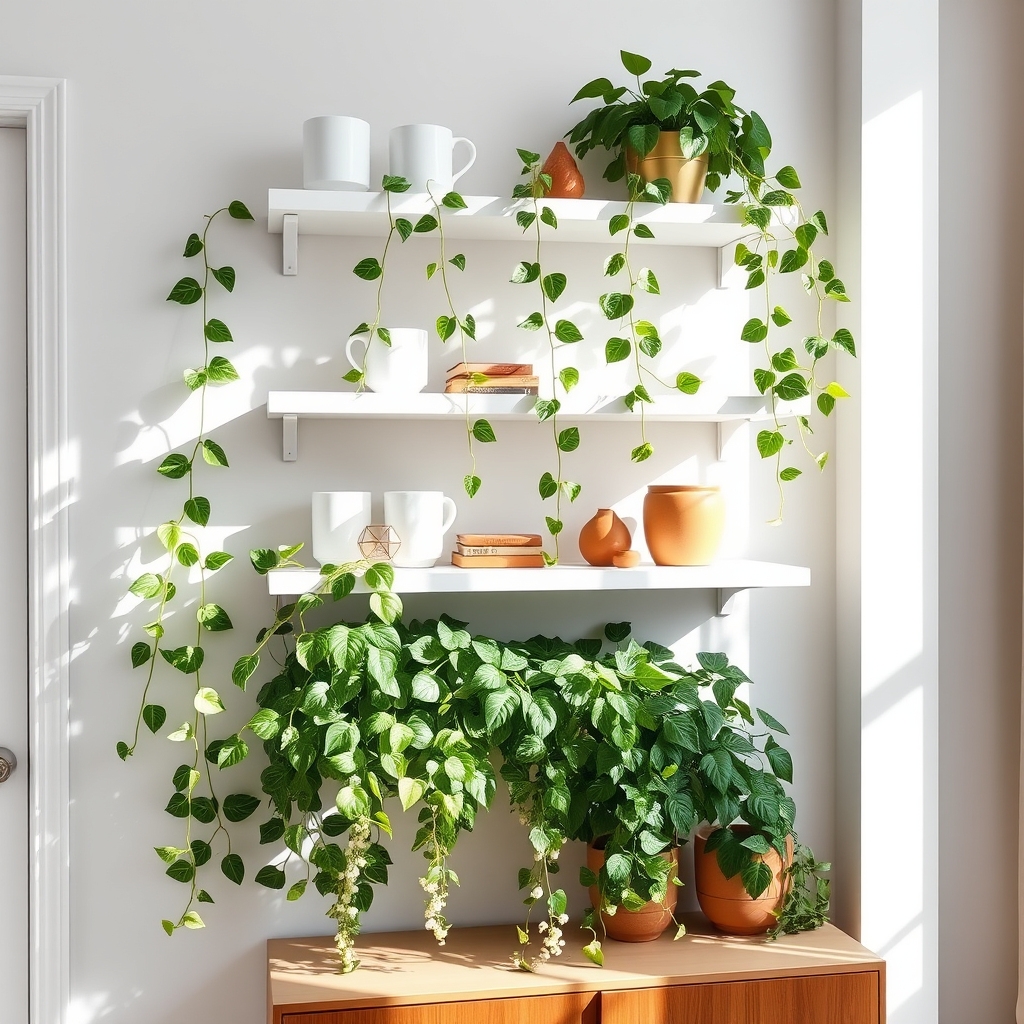
Open shelving adorned with cascading plants creates a dramatic living display that combines functionality with natural beauty. These installations typically feature sturdy floating or mounted shelves where trailing plants like Pothos, String of Pearls, or English Ivy can spill gracefully downward, creating green waterfalls of foliage.
The vertical arrangement maximizes space while adding depth and movement to walls, making it particularly effective in smaller rooms or areas that need visual interest without taking up floor space.
Maintaining cascading plants on open shelves requires regular monitoring of soil moisture, as elevated positions can lead to faster drying. Position plants near but not directly in front of windows to ensure adequate light without scorching leaves, and rotate containers quarterly to promote even growth.
Dust leaves monthly with a damp cloth to maintain photosynthesis efficiency, and trim leggy vines periodically to encourage fuller growth. Install catch trays beneath pots to protect shelving from water damage during watering sessions.
Design a Statement Corner With Large Floor Plants
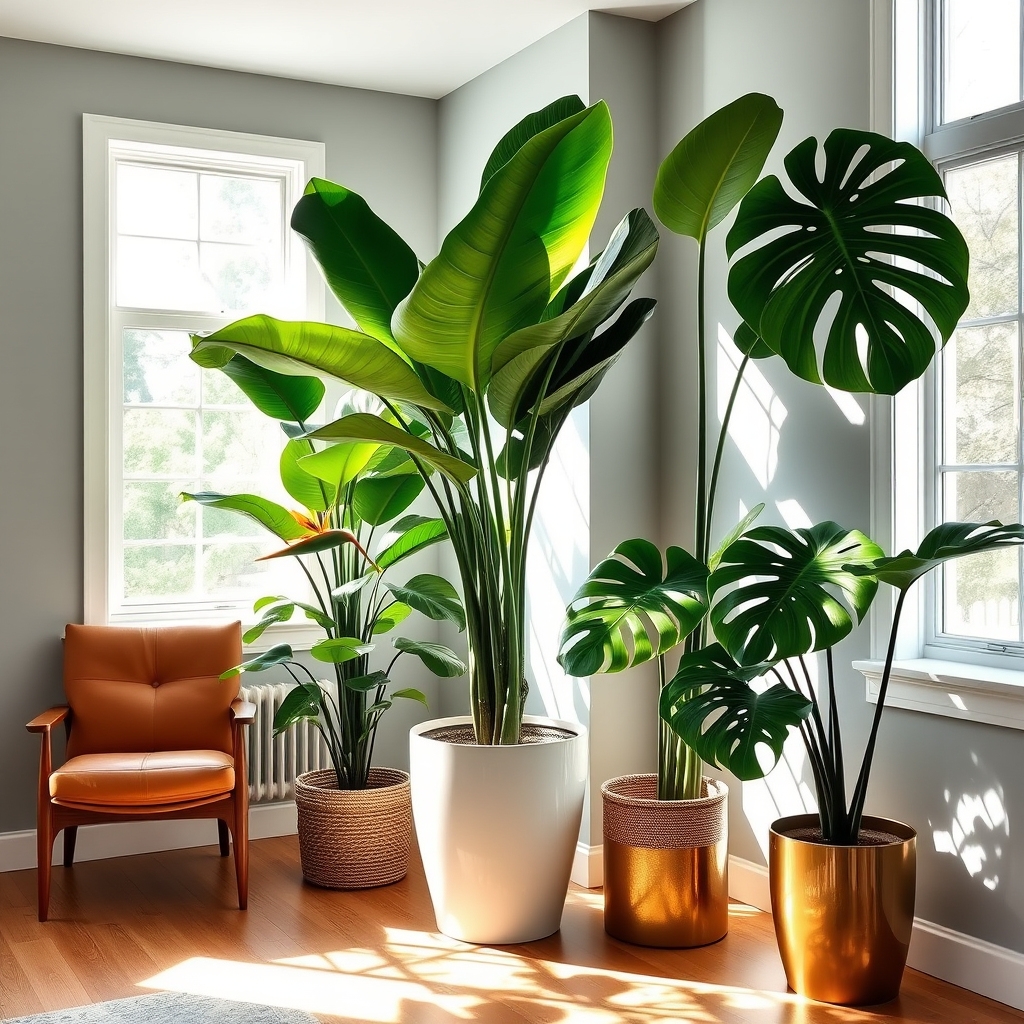
A statement corner featuring large floor plants creates a dramatic focal point that instantly elevates any room’s aesthetic appeal. This design approach typically incorporates towering plants like Fiddle Leaf Fig, Bird of Paradise, or Monstera Deliciosa positioned strategically in a corner space, often complemented by varying heights of planters or stands.
The arrangement can be enhanced by layering smaller plants at different levels, using decorative pots in coordinating colors, and incorporating natural materials like woven baskets or wooden plant stands to create visual interest and depth.
Maintaining a statement corner with large floor plants requires consistent attention to light conditions and spacing needs. Position the plants where they receive adequate natural light according to their specific requirements, while ensuring enough space between specimens to prevent overcrowding and allow proper air circulation.
Rotate the plants quarterly to promote even growth, and regularly dust the large leaves with a damp cloth to maintain their glossy appearance. When watering these substantial plants, use saucers to protect flooring, and check soil moisture levels weekly, as larger plants in bigger pots typically require less frequent but deeper watering.
Hang Floating Plant Shelves at Different Heights
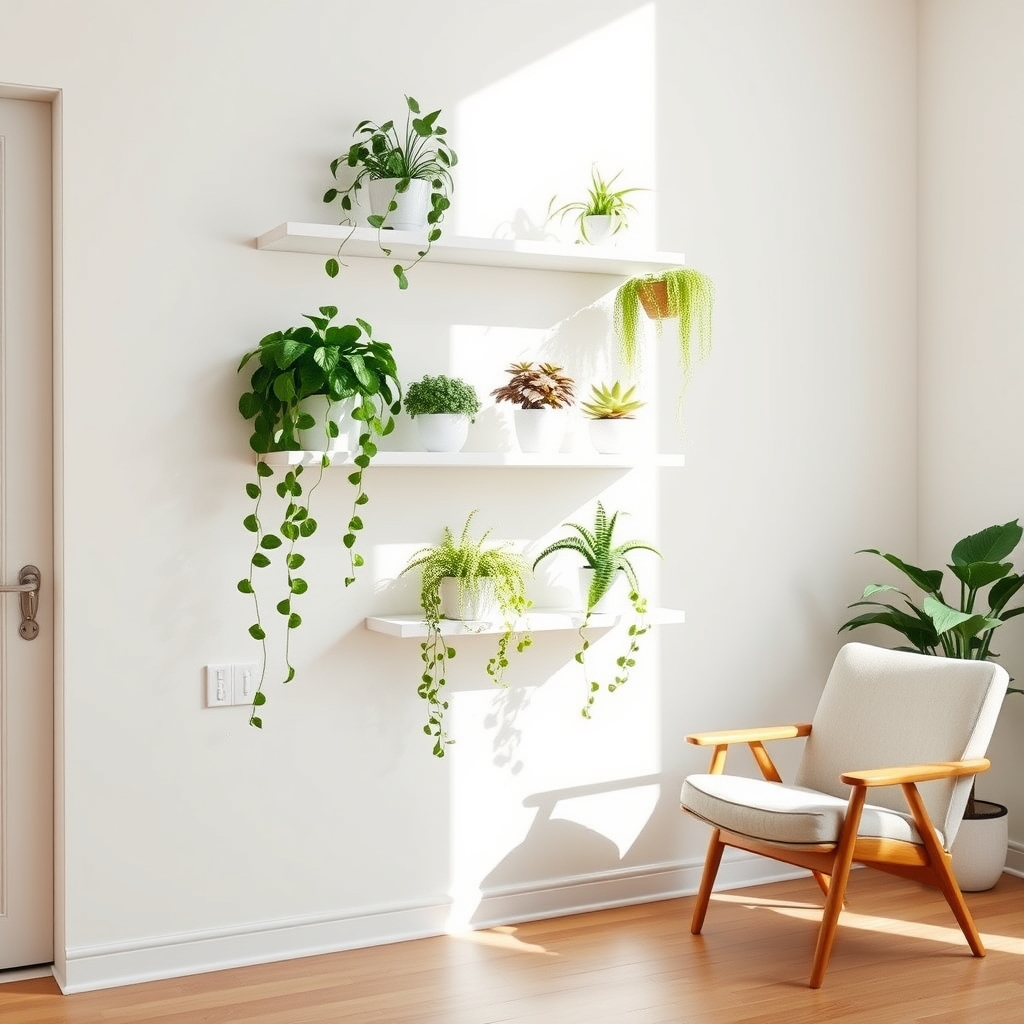
Floating plant shelves create a striking vertical garden effect by appearing to hover against walls at varying elevations, offering a modern and space-saving solution for displaying indoor plants.
These sleek, minimalist shelves can be arranged in asymmetrical patterns or organized rows, allowing plants to cascade at different levels while creating visual interest and depth in any room. The staggered heights not only maximize vertical space but also ensure each plant receives adequate light exposure and creates an artistic living wall display that draws the eye upward.
Regular maintenance of floating plant shelves requires checking the wall anchors every few months to ensure they remain secure and can support the weight of growing plants and moist soil.
Dust both the shelves and plant leaves weekly, and consider rotating plants periodically to promote even growth and prevent them from permanently leaning toward light sources.
When watering plants on floating shelves, use drip trays or take plants down to water them to prevent water damage to walls and ensure proper drainage without compromising the shelf stability.
Arrange a Windowsill Garden Display
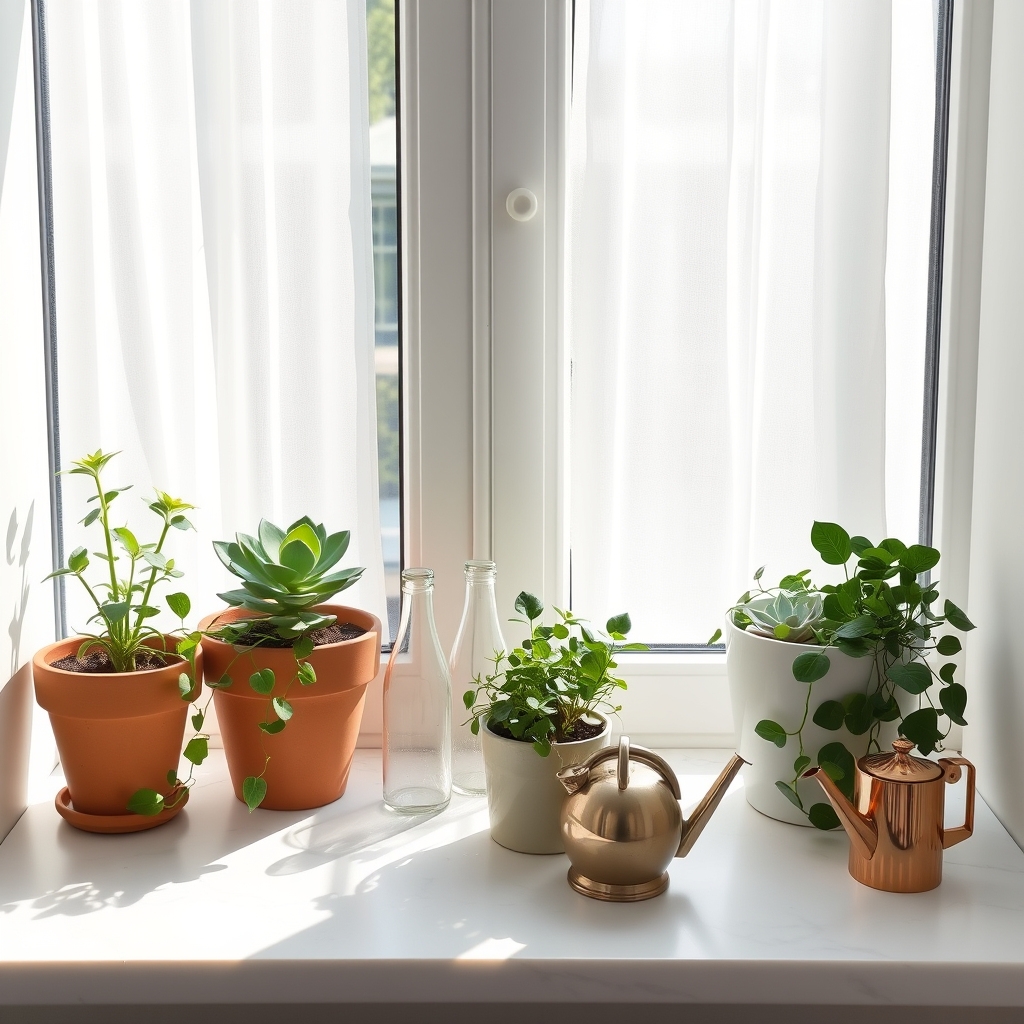
A windowsill garden display transforms an ordinary window ledge into a stunning miniature botanical showcase, featuring a curated arrangement of small indoor plants that thrive in natural light. The display typically incorporates plants of varying heights, textures, and colors, arranged in decorative pots or containers that complement the interior décor.
Succulents, herbs, African violets, and compact trailing plants work particularly well in this setup, creating visual interest through layering while maximizing the limited space available on a typical windowsill.
Maintaining a windowsill garden requires regular monitoring of light exposure, as intense direct sunlight can scorch sensitive plants, while insufficient light may lead to leggy growth. Rotate plants quarterly to ensure even growth, and use saucers under pots to protect the windowsill from water damage.
During winter months, move plants slightly away from cold window glass to prevent leaf damage, and adjust watering frequency based on seasonal changes and heating conditions. Clean window glass regularly to maximize light penetration, and inspect plants weekly for signs of pests that are attracted to the warm, sunny environment.
Mix Plants With Modern Furniture Pieces
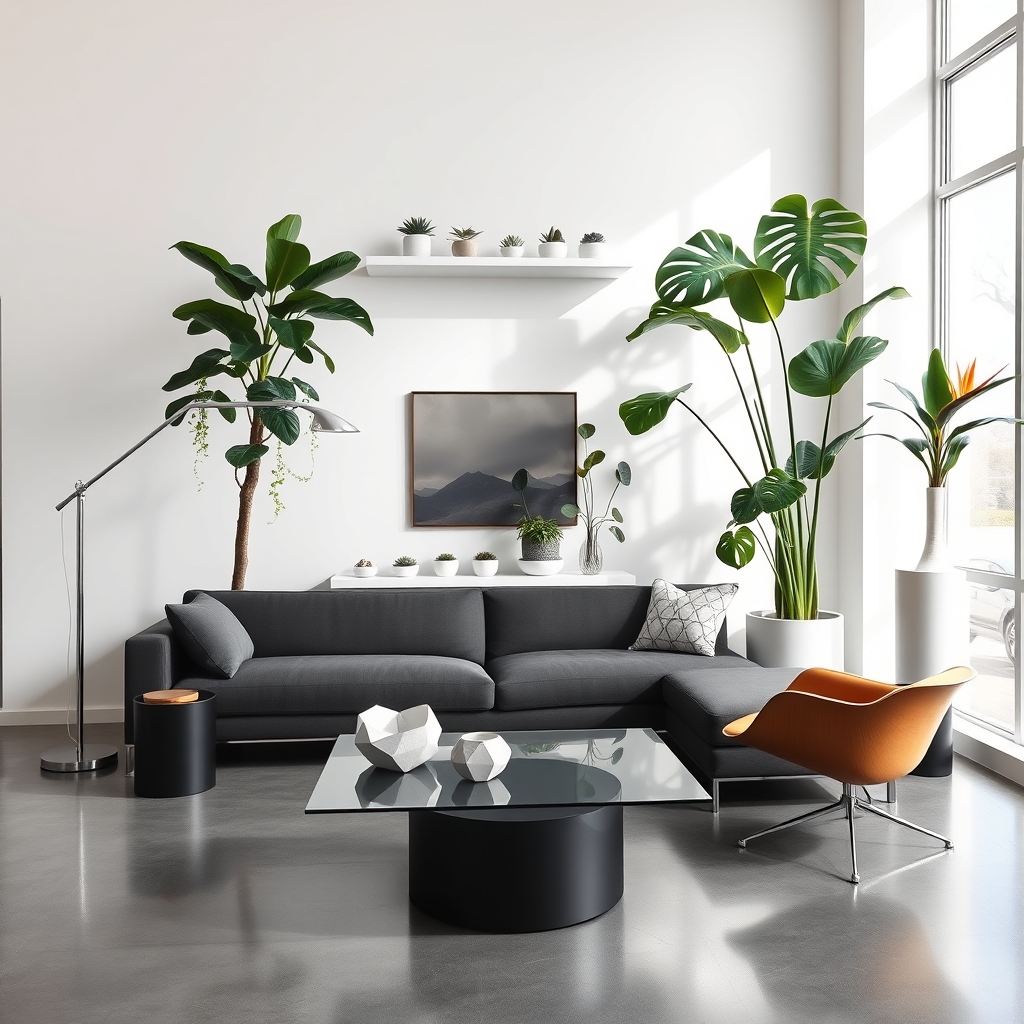
Combining indoor plants with contemporary furniture creates a striking visual contrast that brings organic warmth to modern interiors. Sleek, geometric furniture pieces in materials like glass, metal, or minimalist wood serve as sophisticated backdrops for lush greenery.
Large statement plants like Fiddle Leaf Figs or Bird of Paradise can anchor modern seating areas, while smaller plants on floating shelves or side tables add layers of natural texture. The juxtaposition of clean lines against flowing foliage softens the sometimes stark appearance of modern décor, while maintaining an elevated aesthetic that feels both fresh and sophisticated.
When mixing plants with modern furniture, maintain adequate space between greenery and upholstered pieces to prevent moisture damage and soil stains. Position plants in ways that don’t interfere with furniture functionality or block pathways, and use appropriately sized waterproof plant stands or elevated pots to protect furniture surfaces.
Consider using self-watering planters near valuable furniture pieces to minimize water spillage, and regularly rotate plants to ensure even growth and prevent them from leaning toward light sources in ways that could encroach on furniture spaces.
Set Up a Botanical Bathroom Oasis
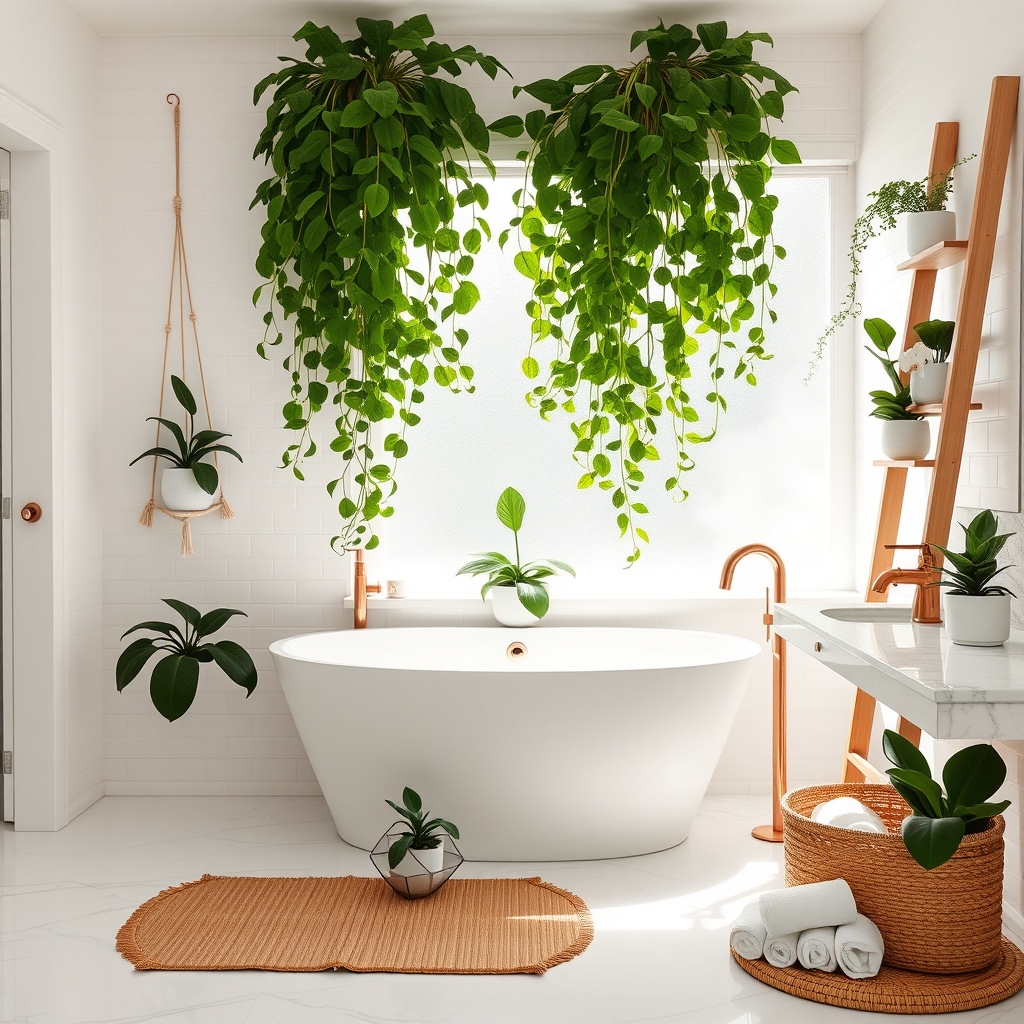
Transform your bathroom into a lush sanctuary by strategically placing moisture-loving tropical plants throughout the space. A botanical bathroom oasis typically features hanging plants like pothos or ferns cascading from shower rods or ceiling hooks, while compact specimens like peace lilies and snake plants occupy windowsills and counter spaces.
The combination of natural humidity, indirect light, and white bathroom fixtures creates a spa-like atmosphere where greenery thrives against sleek surfaces. Bamboo shower mats, natural wood accents, and woven baskets can complement the botanical theme while adding texture and warmth to the space.
Maintaining a bathroom plant collection requires specific care due to the unique environment. Weekly dusting of leaves helps plants maximize light absorption in typically dim bathroom settings, while monitoring soil moisture is crucial as bathroom humidity can sometimes mask dry soil conditions.
Rotate plants quarterly to ensure even growth, and inspect them monthly for signs of mildew, which can develop in humid conditions. Install a small fan or keep the bathroom door open periodically to promote air circulation, and trim yellowing leaves promptly to prevent fungal issues common in moist environments.
Incorporate Plant-Filled Room Dividers
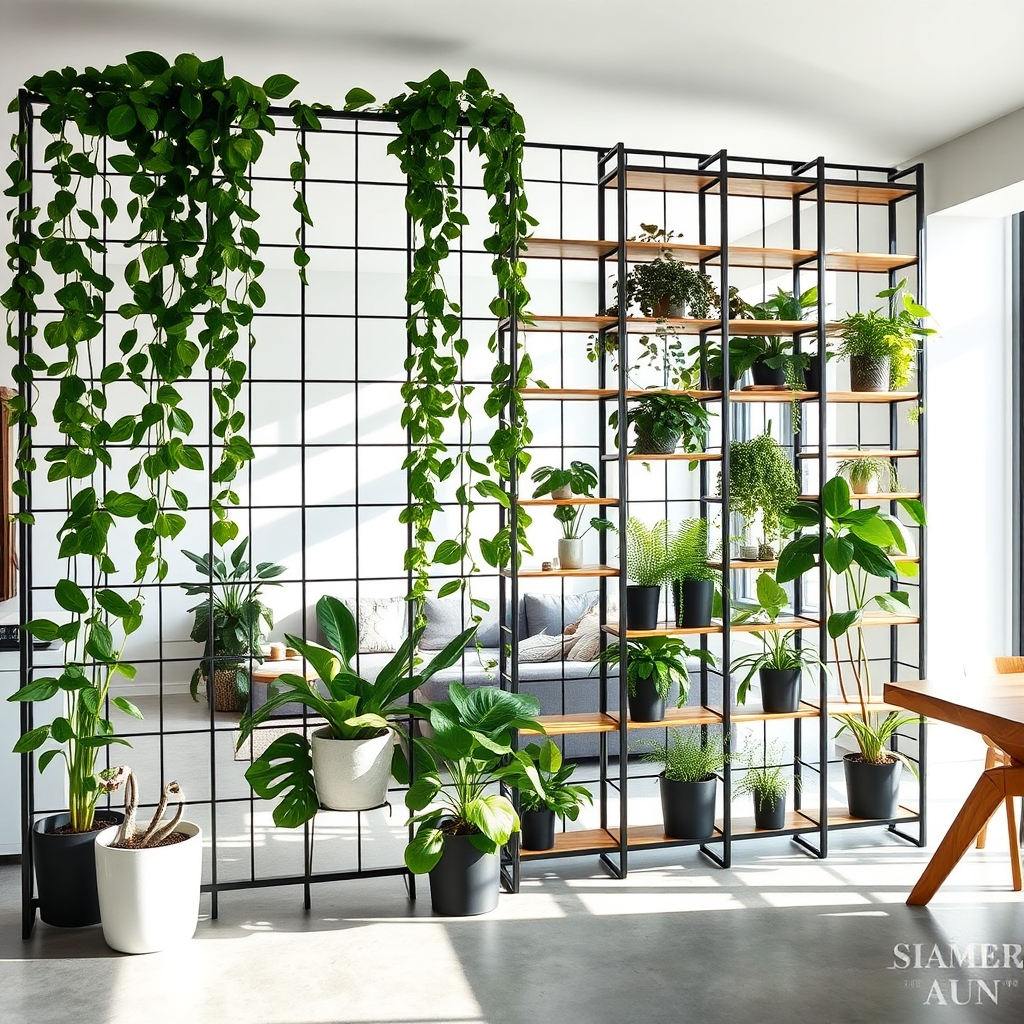
Plant-filled room dividers serve as living walls that elegantly separate spaces while maintaining an open, airy feel. These vertical structures typically consist of metal, wood, or macramé frames fitted with multiple shelves, pockets, or integrated planters that house various indoor plants.
The arrangement can feature a mix of trailing plants like pothos or ivy cascading downward, upright specimens such as snake plants or bamboo palm creating height variation, and compact plants like peperomia or ferns filling middle spaces. This green barrier creates visual interest from both sides while effectively defining distinct areas within a room.
Regular maintenance involves monitoring the varying water needs of different plants within the divider system, as plants at higher levels may dry out faster than those below.
Rotate plants quarterly to ensure even growth on all sides, and dust leaves monthly to maintain optimal photosynthesis. Install a drip tray beneath the divider to catch excess water, and check support structures periodically to ensure they remain stable under the weight of growing plants and wet soil.
Consider installing automated watering systems for larger dividers to maintain consistent moisture levels across all plants.
Transform Your Kitchen With Herb Gardens
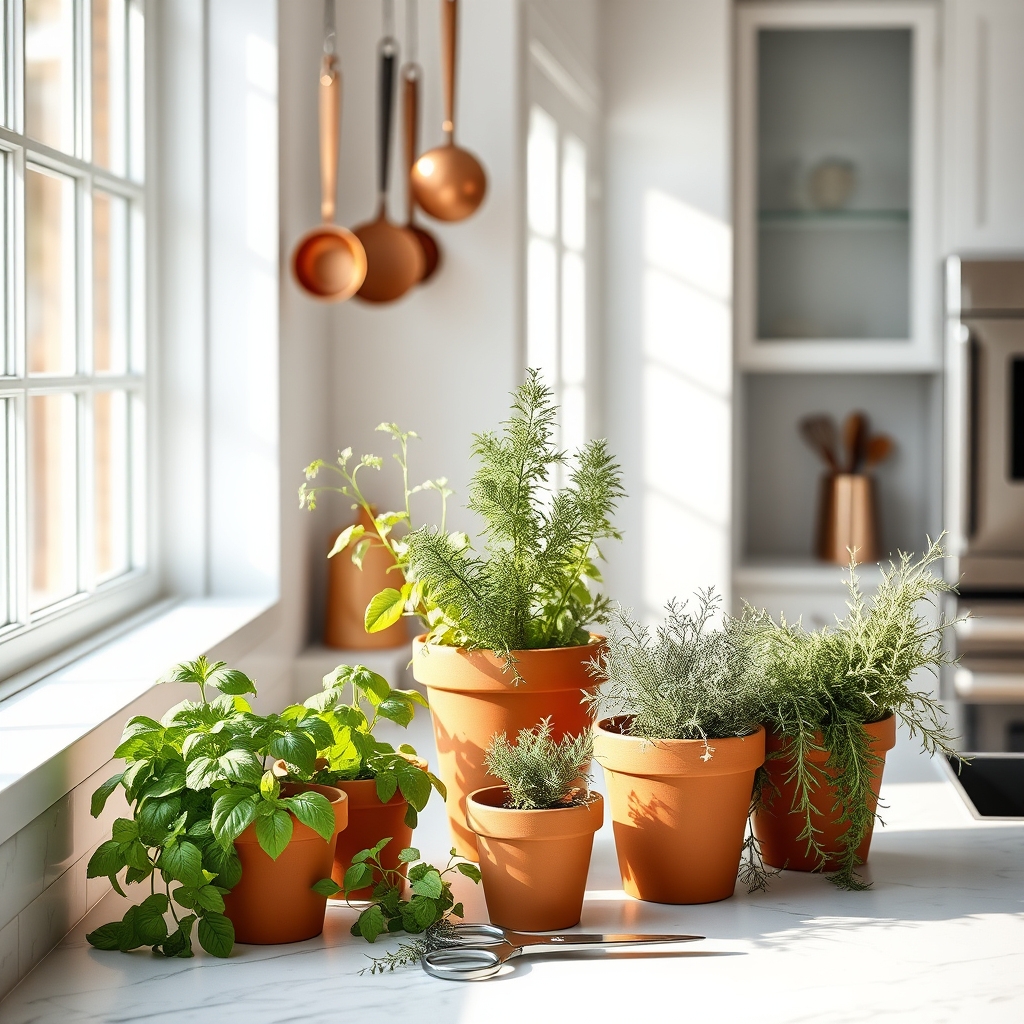
Indoor herb gardens can transform a kitchen into a vibrant, functional space while adding natural beauty and fresh cooking ingredients within arm’s reach. These gardens typically feature a collection of culinary herbs like basil, mint, thyme, and rosemary arranged in matching containers along windowsills, mounted on walls using vertical planters, or displayed on dedicated herb stands.
The unique feature of kitchen herb gardens lies in their dual purpose: they serve as living decor while providing fresh, aromatic ingredients that enhance home cooking and reduce grocery expenses.
Maintaining a kitchen herb garden requires consistent attention to basic care requirements. Water herbs when the top inch of soil feels dry, but avoid overwatering to prevent root rot. Ensure plants receive at least 4-6 hours of sunlight daily, supplementing with grow lights during darker months if necessary.
Regular pruning encourages bushier growth and prevents herbs from becoming leggy; harvest leaves from the top, leaving at least 2/3 of the plant intact. Rotate containers periodically to ensure even growth, and fertilize with a balanced, water-soluble fertilizer once monthly during the growing season.
